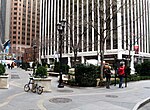Queen Elizabeth II September 11th Garden
2010 establishments in New York City2010 sculpturesBritish terrorism victimsFinancial District, ManhattanForeign relations of the Commonwealth of Nations ... and 7 more
Gardens in New York (state)Memorials for the September 11 attacksMonuments and memorials in ManhattanNew York City geography stubsParks in ManhattanPublic art stubsUnited States garden stubs

The Queen Elizabeth II September 11th Garden is located in Hanover Square in the Financial District of Lower Manhattan, New York City. It commemorates the Commonwealth victims of the September 11, 2001, attack on the World Trade Center. It was officially opened by Queen Elizabeth II on July 6, 2010.
Excerpt from the Wikipedia article Queen Elizabeth II September 11th Garden (License: CC BY-SA 3.0, Authors, Images).Queen Elizabeth II September 11th Garden
Pearl Street, New York Manhattan
Geographical coordinates (GPS) Address Website Nearby Places Show on map
Geographical coordinates (GPS)
| Latitude | Longitude |
|---|---|
| N 40.704607 ° | E -74.009453 ° |
Address
Citi Bike - Pearl St & Hanover Square
Pearl Street
10038 New York, Manhattan
New York, United States
Open on Google Maps










